Introduction
If you’re planning a trip to southern Spain, there’s no better place to discover than Almería. Located in the sun-soaked region of Andalusia, this city is a hidden gem packed with history, nature, and unforgettable local experiences. Whether you’re a beach lover, a culture seeker, or an adventurer, Almería offers the perfect mix of relaxing escapes and exciting things to explore.
In this guide, we’ve curated the top 10 things to do in Almería in 2025, each selected to help you experience the very best the city and its surroundings have to offer. From ancient fortresses and golden beaches to tapas culture and desert adventures, this article is your go-to roadmap for building an unforgettable itinerary.
Let’s dive into the must-see attractions, hidden treasures, and once-in-a-lifetime experiences that make Almería one of the most surprising and rewarding destinations in Spain.
1. Explore the Alcazaba of Almería
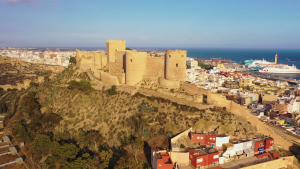
Why the Alcazaba is Almería’s Top Landmark
The Alcazaba of Almería is one of the city’s most iconic and breathtaking landmarks. Built in the 10th century by the Caliphate of Córdoba, this Moorish fortress served as a military stronghold and later as a Christian defensive post after the Reconquista. It’s the second-largest Muslim fortress in Spain, after the Alhambra, and offers incredible panoramic views over the city, the port, and the Mediterranean Sea.
Walking through its massive stone gates and along its ancient walls, you’ll feel the weight of centuries of history under your feet. It’s not only a must-see attraction, but also a symbol of Almería’s identity and a true architectural gem that reflects both Islamic and Christian influences.
Whether you’re a history buff, a photographer, or just someone looking for an amazing view, the Alcazaba won’t disappoint.
What to See Inside the Fortress
Inside the Alcazaba, you’ll find:
- Three distinct defensive enclosures, each representing a different period of the fortress’s history.
- Beautifully maintained gardens with fountains and palm trees, inspired by traditional Islamic garden design.
- Scenic lookout points that give you one of the best views of Almería’s coastline and cityscape.
- Remnants of old homes, military barracks, and towers that tell the story of its evolving function through the centuries.
Every corner of the Alcazaba invites exploration, and there’s something new to discover at every turn.
Tips for Visiting the Alcazaba
- Entry is free for EU citizens, and only a small fee for others.
- Visit early in the morning or late afternoon to avoid the harsh midday sun and get the best lighting for photos.
- Wear comfortable shoes, as there are some stairs and uneven paths.
- Bring water, especially in warmer months—it gets hot on the exposed stone walkways.
- Don’t forget your camera—the views are truly Instagram-worthy.
2. Relax on the Best Beaches in Almería
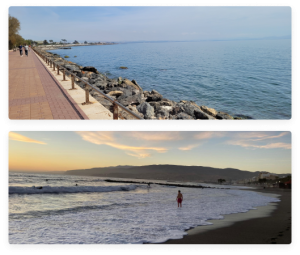
Almería is blessed with some of the most beautiful and unspoiled beaches in all of Spain. Thanks to its location along the Mediterranean coast and its proximity to Cabo de Gata-Níjar Natural Park, visitors can enjoy a mix of wild, natural coves and convenient urban beaches—perfect for sunbathing, swimming, or just unwinding with a view of the sea.
Whether you’re looking for a remote, Instagram-worthy paradise or a beach with easy access to bars and restaurants, Almería has the perfect spot for you.
Playa de los Genoveses
Located within the Cabo de Gata Natural Park, Playa de los Genoveses is the quintessential wild beach. With its golden sand, sand dunes, and surrounding volcanic hills, it’s the kind of place that feels untouched by time. There are no buildings, no beach bars, and no crowds—just nature at its finest.
This beach is ideal for swimming, walking, or relaxing in total peace. Since there are no services, be sure to bring water, snacks, and an umbrella if you’re planning to stay a while.
💡 Tip: Go early in the morning or at sunset to enjoy the magical light and avoid peak heat.
Playa de Mónsul
Another star of Cabo de Gata, Playa de Mónsul is famous for its dramatic lava rock formations and cinematic setting—it even appeared in Indiana Jones and the Last Crusade! The fine sand and calm waters make it perfect for families and snorkelers, and the massive rock in the center of the beach provides a great photo op.
It’s a little more accessible than Genoveses but still feels wild and authentic.
💡 Tip: Parking is limited and controlled in the summer months. Arrive early or use the shuttle service from San José.
Urban Beaches Near the City
If you’re looking for something closer to the city center, Almería has several great urban beaches with promenades, bars, and full facilities:
- Playa del Zapillo: The most popular city beach, lined with restaurants and cafés.
- Playa de San Miguel: A bit quieter, great for families and relaxing swims.
- Costacabana Beach: Known for windsurfing and open space, with a more local feel.
These beaches are perfect for a spontaneous afternoon by the sea—no car needed, and plenty of tapas nearby once you’re done swimming.
3. Discover Cabo de Gata Natural Park

If you’re searching for raw natural beauty, look no further than the Cabo de Gata-Níjar Natural Park. This protected coastal area is a true paradise for hikers, photographers, and nature lovers, offering a unique combination of volcanic cliffs, hidden coves, and desert landscapes. It’s one of the most ecologically rich and visually striking areas in southern Spain.
Visiting Cabo de Gata gives you a completely different view of Almería—one that’s untouched, wild, and unforgettable.
Top Hiking Trails and Scenic Spots
The park is crisscrossed by scenic hiking trails that offer incredible views of the coast and lead to secluded beaches you can only reach on foot. Some of the top routes include:
- Sendero Genoveses–Mónsul: An easy and beautiful coastal trail connecting two of the area’s most iconic beaches.
- El Faro de Cabo de Gata to Arrecife de las Sirenas: A short trail offering dramatic ocean views and a historic lighthouse.
- Las Amoladeras Trail: A flat, family-friendly path through arid landscapes filled with native flora and fauna.
Bring sturdy shoes, sunscreen, and plenty of water—most trails are exposed to the sun and have little to no shade.
Wildlife and Nature Watching
Cabo de Gata is also a hotspot for birdwatching and biodiversity. Its salt flats (salinas) near San Miguel de Cabo de Gata attract hundreds of flamingos during migration seasons, along with other exotic birds.
You’ll also spot rare desert plants, wild herbs, and volcanic rock formations, making every walk feel like an ecological adventure. The contrast between arid mountains and turquoise waters is stunning—and totally unique in Europe.
How to Get There and What to Bring
- By car: Renting a car is the easiest way to explore the park at your own pace. Many beaches and trails are only accessible this way.
- By bus or bike: Limited options are available, especially during high season, but planning ahead is essential.
- What to bring: Sunscreen, a hat, good walking shoes, snacks, and plenty of water. There are few shops or restaurants within the park itself.
💡 Important: Always stay on marked trails and respect the natural environment—this is a protected space that relies on responsible tourism.
4. Experience Almería’s Tapas Culture
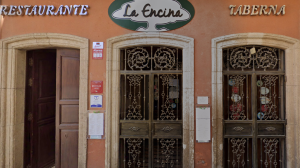
One of the most iconic and beloved aspects of Almería’s lifestyle is its legendary tapas culture. Unlike most places in Spain, where tapas are ordered separately, in Almería, you receive a free tapa with every drink—yes, every single one. It’s a tradition that locals fiercely protect and one that makes eating out both fun and affordable.
Whether you’re a foodie or a casual traveler, a tapear (tapas crawl) is an absolute must when visiting Almería.
What Makes Tapas in Almería Unique
Almería is one of the last cities in Spain where the free tapa tradition is still alive and well. Every time you order a beer, glass of wine, or soft drink, you’re given a free tapa of your choice. In most bars, you’ll even be shown a menu with several options, ranging from jamón ibérico and grilled octopus to mini hamburgers and vegan specialties.
This tradition transforms a simple drink into a full culinary experience and encourages social interaction. It’s not just a meal—it’s a way of life.
Best Tapas Bars to Try
Here are some of the most beloved spots where you can enjoy authentic tapas in Almería:
- Casa Puga – One of the oldest tapas bars in the city, famous for its traditional dishes and cured hams hanging from the ceiling.
- La Mala – A modern, lively bar with creative tapas and a great selection of wines and cocktails.
- Jovellanos 16 – Known for fresh seafood tapas and a cozy local vibe.
- Taberna Nuestra Tierra – Focused on locally sourced ingredients and traditional Almerían recipes.
- Bonillo – A great place to try tortilla, croquettes, and other home-style tapas.
💡 Pro Tip: Start your tapas crawl around 8:30–9:00 PM when locals begin to go out. It’s a great way to blend in and get the full experience.
How the Free Tapa Tradition Works
- Step 1: Order your drink. Beer (caña), wine, tinto de verano, or even soda.
- Step 2: Choose your tapa if the bar offers a menu (many do). Otherwise, they’ll surprise you.
- Step 3: Repeat! At every new bar, you’ll get a new tapa—so the more you explore, the more you taste.
It’s an incredibly affordable way to dine, and a night out usually turns into a tour of flavors and local culture.
5. Visit the Almería Cathedral
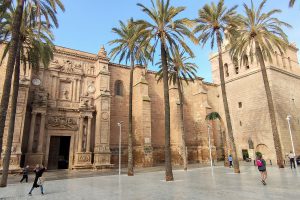
Almería’s architectural crown jewel is its fortress-cathedral, an extraordinary building that combines religious grandeur with military design. Unlike most cathedrals in Spain, the Cathedral of Almería was built not only to inspire awe, but also to protect the city from pirate attacks and coastal invasions—a real reflection of Almería’s turbulent past.
Visiting the cathedral is like stepping into a time capsule of Gothic, Renaissance, and defensive architecture all in one.
History of the Fortress-Cathedral
Construction began in the 16th century, on the ruins of a mosque that had been destroyed by an earthquake. But what truly sets this cathedral apart is its dual purpose: while it was built as a place of worship, it was also designed to serve as a stronghold against frequent Berber pirate raids.
This resulted in a building with high stone walls, corner towers, and a fortified façade—features more commonly found in castles than in cathedrals.
Architectural Highlights and Interior
Inside, the cathedral impresses with its lofty nave, ribbed vaults, and ornate chapels. The altarpiece is particularly striking, featuring fine sculptures and religious imagery in both Gothic and Baroque styles.
Other highlights include:
- A beautiful cloister that offers a peaceful escape from the busy city.
- The choir stalls carved in dark wood with intricate detail.
- A small but informative museum containing sacred art, vestments, and historical documents.
It’s a building that rewards careful observation—you’ll see the blend of aesthetics and function in every arch and corridor.
Location and Visiting Hours
- 📍 Located in Plaza de la Catedral, right in the heart of the historic center.
- 🕒 Open Monday to Saturday. Hours vary slightly by season.
- 🎟️ Tickets cost around €5, with discounts for students, seniors, and children. Audio guides are usually available in several languages.
💡 Tip: Visit in the late afternoon when the sunlight hits the sandstone walls and casts golden reflections across the square. It’s the perfect photo opportunity.
6. Walk Through the Historic Center
Exploring the historic center of Almería is one of the most rewarding and authentic ways to connect with the city. This area, rich in character and charm, offers a blend of Moorish heritage, Andalusian architecture, and vibrant local life. You won’t need a map—just stroll and let the winding streets guide you to hidden corners, beautiful plazas, and centuries-old buildings.
It’s an experience where history meets the present, and every alley tells a story.
Streets, Plazas, and Hidden Gems
Almería’s old town is full of narrow, whitewashed streets where every turn reveals something surprising. Balconies overflow with flowers, tiled fountains appear in quiet courtyards, and traditional bakeries offer the scent of freshly made pastries.
Keep an eye out for:
- Historic façades with Arabic and Gothic details.
- Local shops selling handcrafted ceramics and textiles.
- Small squares where locals gather to talk, eat, and play.
It’s a perfect setting to slow down and simply absorb the rhythm of daily life in Andalusia.
Plaza Vieja and Surrounding Sites
One of the most iconic spots in the historic center is Plaza Vieja, also known as Plaza de la Constitución. This wide square is surrounded by neoclassical buildings and swaying palm trees, making it a lovely place to rest and people-watch.
From here, you can easily reach:
- The Almería Town Hall, housed in a stately 19th-century building.
- The Refugios de la Guerra Civil, just a few blocks away.
- Several nearby tapas bars for a quick refreshment between sightseeing stops.
💡 Local tip: Sit at one of the outdoor cafés with a cold drink and enjoy the timeless view—especially beautiful as the sun sets over the square.
Best Times to Explore on Foot
- Morning: Ideal for cooler temperatures and quiet streets before shops open.
- Late afternoon: Great lighting for photos and a lively local atmosphere.
- Evening: The perfect time to combine your walk with a tapas crawl through the old town.
No matter when you go, walking the historic center will give you a genuine taste of Almería’s personality.
7. Watch a Flamenco Show

No trip to southern Spain would be complete without experiencing the raw emotion and cultural power of flamenco, and Almería is no exception. Deeply rooted in Andalusian identity, flamenco is more than just music and dance—it’s storytelling through passion, and watching it live is one of the most unforgettable things to do in Almería.
From cozy tablaos to open-air festivals, the flamenco scene here is authentic, moving, and intimate.
Where to See Flamenco in Almería
For a truly immersive experience, head to Tablao Flamenco La Canastera, one of the city’s most respected flamenco venues. Located in a traditional Andalusian setting, this space offers close-up performances with guitarists, singers, and dancers who live and breathe flamenco.
Other places worth checking out include:
- Clasijazz – A cultural center with a diverse music program that often includes flamenco nights.
- Almería Flamenco & Dance Festival – Held every summer across historic plazas and public spaces, with dozens of free and ticketed shows.
💡 Tip: Ask your host or hotel staff about local events—many flamenco performances aren’t heavily advertised and feel like well-kept secrets.
What to Expect at a Tablao Flamenco
A flamenco show typically consists of:
- A guitarist (tocador) playing intense, intricate rhythms.
- A singer (cantaor) delivering deep, emotional vocals.
- One or more dancers (bailaores) who channel the music into powerful, expressive movement.
Shows are intimate and intense, with raw energy and improvisation that can move the audience to silence or spontaneous applause. Expect goosebumps.
Many venues offer a drink with your ticket, and seating is usually limited—so book early for the best view.
Why Flamenco Is Part of Andalusian Culture
Flamenco has its roots in the mix of Gypsy, Moorish, Jewish, and Andalusian influences that shaped the region’s identity over centuries. It’s considered a UNESCO Intangible Cultural Heritage, and for good reason—it expresses stories of love, struggle, joy, and pain like no other art form.
In Almería, flamenco is not just a performance—it’s part of the soul of the city. Watching it live connects you to that spirit in the most direct, emotional way possible.
8. Take a Day Trip to Mojácar or Níjar
While Almería city has plenty to offer, one of the best ways to expand your trip is by taking a day trip to nearby villages that showcase the traditional charm and artistry of the region. Two standout destinations are Mojácar, a hilltop town overlooking the sea, and Níjar, a cultural hub famous for crafts and natural beauty.
These towns offer a slower pace, postcard-worthy views, and a glimpse into Andalusia’s rural soul.
What to See in Mojácar
Perched dramatically on a hill with whitewashed buildings and winding alleys, Mojácar Pueblo is considered one of the most beautiful villages in Spain. It’s a haven for artists, romantics, and anyone drawn to Mediterranean charm.
Highlights include:
- Mirador del Castillo – A stunning viewpoint offering panoramic views of the valley and sea.
- Santa María Church – A fortified church that reflects the town’s layered history.
- Plaza Nueva – The heart of the town, perfect for a drink with a view.
Below the village, you’ll find Mojácar Playa, a lively beach area filled with bars, shops, and sun loungers—ideal for a mix of culture and relaxation.
Crafts and Local Culture in Níjar
Inland from Almería and at the edge of Cabo de Gata, Níjar is a smaller, quieter village known for its artisanship and local traditions. This is the perfect place to shop for:
- Handwoven rugs and textiles (jarapas)
- Colorful ceramics
- Locally made pottery and crafts
You’ll also love the tranquil streets, white houses with blue trim, and the hospitality of locals who are proud of their heritage.
💡 Tip: Níjar is also a great base for exploring the desert landscapes and scenic drives of the surrounding park.
How to Get There and Back
- 🚗 By car: Mojácar is about 1 hour from Almería, and Níjar just 35 minutes.
- 🚌 By bus: There are buses from Almería to both towns, but schedules are limited, especially on weekends.
- 🚐 Guided day tours: Available through local operators and often include both villages.
If you have a free day in your itinerary, visiting one or both of these towns is a beautiful way to experience another side of Almería—full of local flavor, color, and authenticity.
9. Visit the Tabernas Desert
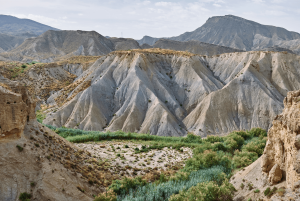
Did you know Spain has its own desert? Just 30 km north of Almería lies the Tabernas Desert, the only true desert in mainland Europe. With its arid hills, dramatic rock formations, and sun-scorched canyons, this otherworldly landscape has served as the backdrop for hundreds of films and series—making it a paradise for cinephiles, photographers, and nature lovers alike.
It’s a must-see if you’re looking for something truly unique during your time in Almería.
Why It’s Known as Europe’s Only Desert
The Tabernas Desert receives less than 250 mm of rain per year, giving it a genuine semi-arid desert climate. The terrain is dry, rugged, and strikingly similar to the American Southwest, which is why so many Westerns were filmed here in the 1960s and 70s.
Beyond the film history, the desert also hosts unique flora and fauna adapted to its extreme conditions, making it a valuable ecological zone as well as a cinematic icon.
Film Locations and MiniHollywood Park
One of the top attractions in the area is Oasys MiniHollywood, a theme park built on the set of old spaghetti westerns like The Good, the Bad and the Ugly. Here you can enjoy:
- Live cowboy shows with stunts and horse riding.
- A Western village where you can dress up and take photos.
- A small zoo and swimming pool area, ideal for families.
If you’re a movie fan, you can also visit Fort Bravo or Western Leone, other preserved film sets open to the public. These spots let you walk through the sets where Clint Eastwood and other stars once filmed.
Best Time to Visit the Desert
- ☀️ Spring and autumn are ideal: temperatures are warm but bearable, and the light is perfect for photos.
- ❄️ Winter can be surprisingly chilly, especially in the morning and evening.
- 🔥 Summer gets extremely hot—visit early in the morning or late in the afternoon to avoid heatstroke.
💡 Essential tip: Bring plenty of water, sun protection, and a hat. There is very little shade, and the sun is intense even in cooler months.
Whether you’re drawn by its cinematic legacy or its wild natural beauty, the Tabernas Desert is one of the most surprising and rewarding places to visit in Almería.
10. Explore Almería’s Museums
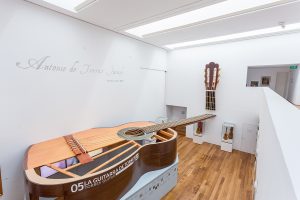
Almería isn’t just about sun and nature—it also boasts a rich cultural and artistic scene. The city’s museums are compact, accessible, and full of fascinating stories about local history, music, cinema, and art. Whether you’re interested in flamenco guitars, the Spanish Civil War, or contemporary painting, you’ll find a museum here that will surprise and inspire you.
They’re also a great way to escape the midday heat while diving deeper into the soul of Almería.
Guitar Museum and Antonio de Torres
One of the city’s most unique and beloved museums is the Museo de la Guitarra Española, dedicated to Antonio de Torres, the Almerían luthier considered the father of the modern classical guitar. This interactive space invites visitors to:
- Learn about the history and evolution of the guitar.
- Explore Torres’ workshop recreations and design innovations.
- Enjoy a sound room where you can actually play different guitars.
It’s a must-visit for music lovers, and its location near the Cathedral makes it easy to include on a walking tour of the old town.
Civil War Shelters and Local History
Hidden beneath the streets of the city are the Refugios de la Guerra Civil—a network of underground air-raid shelters built during the Spanish Civil War. Stretching over 4 km, they once protected up to 40,000 people from bombings.
Today, you can visit a portion of the tunnels on a guided tour, where you’ll:
- Walk through the original passageways, lined with benches and support structures.
- Hear stories of everyday survival during one of Spain’s darkest periods.
- See exhibitions of war-time relics, photographs, and local testimonies.
It’s a moving, eye-opening experience and one of the most impactful historical visits in Almería.
Contemporary Spanish Realism Museum
Located in a beautifully restored 16th-century hospital, the Museum of Contemporary Spanish Realism (opened in 2024) showcases a permanent collection of over 260 works of art from the 20th century to today.
Inside, you’ll find:
- Paintings by some of Spain’s most acclaimed realist artists.
- Temporary exhibitions focused on modern Spanish identity and society.
- A calm, elegant space perfect for slow viewing and reflection.
It’s an ideal stop for art lovers and those interested in Spain’s more recent creative voices.
With just a few museum visits, you’ll gain a deeper understanding of Almería’s culture, struggles, and contributions to the world of art and music.
Conclusion
Almería is one of Spain’s most underrated treasures—a place where history, nature, food, and culture meet under endless blue skies. From exploring ancient Moorish fortresses to relaxing on wild Mediterranean beaches, or from sipping wine with free tapas to watching flamenco under the stars, this city offers a rich and varied experience that feels both authentic and unforgettable.
Whether you’re spending just a weekend or planning a longer stay, these 10 activities will help you connect with the true essence of Almería. You won’t just see the city—you’ll feel it.
So pack your bags, grab your camera, and prepare to fall in love with Almería.
<strong>Looking for the perfect place to stay?</strong>
📍 Book your accommodation at Casa Vicki—a centrally located vacation home designed to help you experience Almería in comfort and style.
Frequently Asked Questions
Is Almería worth visiting in 2025?
Yes! It’s one of Spain’s most authentic and sunniest destinations, perfect for culture, beaches, and tapas.
What is the most famous attraction in Almería?
The Alcazaba fortress—a historic Moorish castle with stunning views over the city.
Can I explore Almería without a car?
Yes. The city is very walkable, but for exploring Cabo de Gata or nearby towns, a car is recommended.
How many days do you need in Almería?
Ideally 3 to 4 days to enjoy the city, beaches, and a day trip to places like Mojácar or the Tabernas Desert.